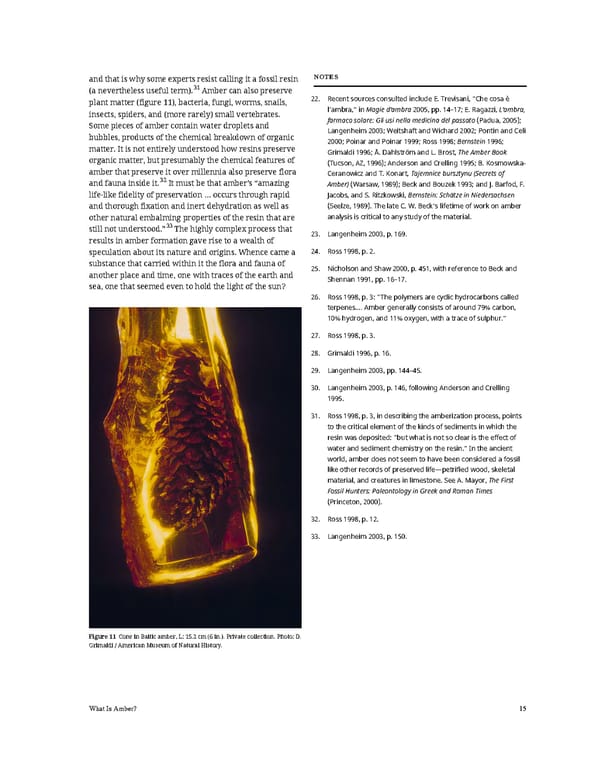and that is why some experts resist calling it a fossil resin NOTES (a nevertheless useful term).31 Amber can also preserve plant matter (figure 11), bacteria, fungi, worms, snails, 22. Recent sources consulted include E. Trevisani, “Che cosa è insects, spiders, and (more rarely) small vertebrates. l’ambra,” in Magie d’ambra 2005, pp. 14–17; E. Ragazzi, L’ambra, Some pieces of amber contain water droplets and farmaco solare: Gli usi nella medicina del passato (Padua, 2005); bubbles, products of the chemical breakdown of organic Langenheim 2003;Weitshaft and Wichard 2002; Pontin and Celi matter. It is not entirely understood how resins preserve 2000; Poinar and Poinar 1999; Ross 1998; Bernstein 1996; Grimaldi 1996; Å. Dahlström and L. Brost, The Amber Book organic matter, but presumably the chemical features of (Tucson, AZ, 1996); Anderson and Crelling 1995; B. Kosmowska- amber that preserve it over millennia also preserve flora Ceranowicz and T. Konart, Tajemnice bursztynu (Secrets of and fauna inside it.32 It must be that amber’s “amazing Amber)(Warsaw, 1989); Beck and Bouzek 1993; and J. Barfod, F. life-like fidelity of preservation … occurs through rapid Jacobs, and S. Ritzkowski, Bernstein: Schätze in Niedersachsen and thorough fixation and inert dehydration as well as (Seelze, 1989). The late C. W. Beck’s lifetime of work on amber other natural embalming properties of the resin that are analysis is critical to any study of the material. still not understood.”33 The highly complex process that results in amber formation gave rise to a wealth of 23. Langenheim 2003, p. 169. speculation about its nature and origins. Whence came a 24. Ross 1998, p. 2. substance that carried within it the flora and fauna of 25. Nicholson and Shaw 2000, p. 451, with reference to Beck and another place and time, one with traces of the earth and Shennan 1991, pp. 16–17. sea, one that seemed even to hold the light of the sun? 26. Ross 1998, p. 3: “The polymers are cyclic hydrocarbons called terpenes.… Amber generally consists of around 79% carbon, 10% hydrogen, and 11% oxygen, with a trace of sulphur.” 27. Ross 1998, p. 3. 28. Grimaldi 1996, p. 16. 29. Langenheim 2003, pp. 144–45. 30. Langenheim 2003, p. 146, following Anderson and Crelling 1995. 31. Ross 1998, p. 3, in describing the amberization process, points to the critical element of the kinds of sediments in which the resin was deposited: “but what is not so clear is the effect of water and sediment chemistry on the resin.” In the ancient world, amber does not seem to have been considered a fossil like other records of preserved life—petrified wood, skeletal material, and creatures in limestone. See A. Mayor, The First Fossil Hunters: Paleontology in Greek and Roman Times (Princeton, 2000). 32. Ross 1998, p. 12. 33. Langenheim 2003, p. 150. Figure 11 Cone in Baltic amber, L: 15.2 cm (6 in.). Private collection. Photo: D. Grimaldi / American Museum of Natural History. What Is Amber? 15
 Ancient Carved Ambers in the J. Paul Getty Museum Page 24 Page 26
Ancient Carved Ambers in the J. Paul Getty Museum Page 24 Page 26